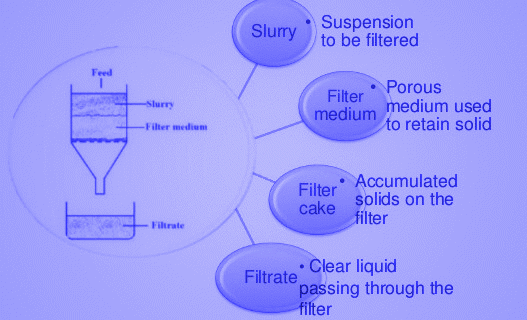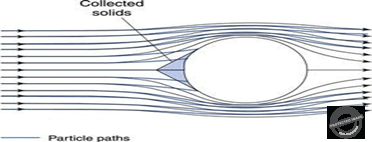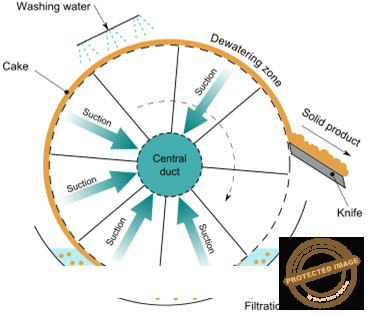Terms used in Filtration
- FILTRATION may be defined as the “Separation of solids from a fluid by means of a porous medium that retains the solids but allows the fluid to pass.
- CLARIFICATION: When solid does not exceed 1.0%, filtration is termed as clarification & filtrate is the primary product.
- STRAINING: The object of filtration is to remove large visible particles using a coarse filtering medium (muslin/cotton wool).
- ULTRA-FILTRATION: Separation of inter-micellar liquid from solid by use of high pressure on a semi-permeable membrane
- SLURRY/FEED: Suspension of solid in liquid to be filtered
- FILTER MEDIUM: Porous medium used to retain/entrap the solids
- FILTER CAKE/RESIDUE: Accumulation of solids on the filter medium
- FILTRATE/EFFLUENT: Clear liquid passing through the filter medium
- CAKE FILTRATION: If the recovery of the solid is desired, the process is called cake filtration.

Difference between clarification & filtration
FILTRATION
FILTRATION may be defined as the “Separation of solids from a fluid by means of a porous medium that retains the solids but allows the fluid to pass.
CLARIFICATION:
CLARIFICATION: When solid does not exceed 1.0%, filtration is termed as clarification & filtrate is the primary product.
Darcy’s Theory (Rate of Filtration)

Darcy’s Theory (Rate of Filtration)
V= Volume of filtrate
K= Permeability coff.
A=Area of filter bed
∆P= Pressure difference on liquid & below the filter medium
η= Viscosity of liquid
l= thickness of filter cake
Factor affecting the rate of filtration
- Factor affecting the rate of filtration
- Filtration
- Viscosity
- Surface area of filter media
- Temp.
- Particle size
- Pore size of filter media
- Thickness of cake
- Nature of solid materials (porosity of filter cake)
TYPES OF FILTER MEDIA
- TYPES OF FILTER MEDIA
- Filter paper (Grade-Coarse, medium & fine)
- Glass wool (Corrosive liquids)
- Cotton wool
- Asbestos(Al. silicate): Corrosive liquids, Alkalinity of filtrate)
- Sintered glass: borosilicate glass, Parenteral, corrosive liquid & Oxidising agents)
- Membrane filter
- Filter cloths
FILTER AIDS:
Substances that reduce the resistance of the filter cake & increase the filtration. (Added to the liquid slurry to be filtered)
Filter aids Should form a porous cake & Insoluble in liquid
Filter aids forms a fine surface deposit- prevent solid from contacting & plugging the supporting filter medium.
Filter aids added by 2 methods:
- Pre-coating &
- Body mix
List of Filter aids used in Pharmaceutical preparations
| Materials | Composition | Advantage | Disadvantage |
|---|---|---|---|
| Carbon | Carbon | Filtering strong alkaline solutions | Coarse grade only & Expensive |
| Cellulose | Cellulose | Higy purity & Excellent chemical resistance | Expensive |
| Diatomaceous earth | Silica | Wide range; Used for very fine filtration | Slightly soluble than diatomites in acid & alkali |
| Asbestos | Aluminosilicate | Good retention on coarse screens | More soluble than diatomites in acid & alkali |
| Perlite | Silica & Aluminosilicate | Wide range; not capable of finest retention | More soluble than diatomites in acid & alkali |
Mechanism OF FILTRATION

- Straining like Sieving = pores are smaller than the particles so that particles are retained on the filler medium.
- Impingement = Streamlined strike the cylinder- triangular ridge
- Entanglement = particles are smaller than the pores; so Particle became entangled
- Attractive forces:- the potential difference is used; Particles may collect on a filter medium as a result of attractive forces.
Filtration Equipment
- Filter leaf
- Filter press – plate & Frame
- Meta-filter
- Membrane filter
- Sintered filter
- Rotary filter
- Filter candle
List of Filtration Equipment used in Pharmaceutics
| Filtration equipment | Advantage | Disadvanctage | Remarks |
|---|---|---|---|
| Filter leaf | Removal of Cake: Reverse of Airflow or Immersing the filter in a water | Batch process/Non-continuous | use for slurry up to 5 % No. of leaves are connected to the common outlet (to provide large surface area) = Sweetland filters |
| Filter press – plate & Frame (2 units – plate & frame press) | – Large volume can be handled/filtered. – Provide a large surface area for filtration -Filtering media can be used repeatedly by washing -Surry – max 5% & produce dry cake -Bears up to 20 bars (withstand) | – Batch process / Not continuous process – Slum upto 5% – Costlier – labour is required for washing & replacement of filter cloth – Leakage between plate may take place | Frame-Receive/inlet; Plate-Support filter cloth & outlet |
| Meta-filter (Edge filter -Corrosive Liquid) | Backflushing = Removal of cake Withstand High pressure & corrosive liquids | -Clarification of syrups elixir & parenteral solution (more viscous liquid) – Withstand High pressure & corrosive liquids | |
| Membrane filter (Made of cellulose nitrate & cellulose acetate, polyamide, polysulfone or silver) | -Thickness 50 – 150 micrometer(120 micrometer Average) -No. of pores: 400 – 500 pores per cm2 – Uniformity in pore size | -Required Rigid Perforated Support for membrane filter -Pre-filtration required to prevent clogging of a membrane -Can not be used for filtration of – organic solvents (alcohols, Keton as, esters, CHCl3) | -Used for sterilization of both Aq & Non-Aq preparation Liquids -Disposable, so No cross-contamination but costly |
| Sintered filter (Made of Borosilicate glass) | |||
| Rotary filter | -can Handle – Conc. Slurry (15-30%) -Continuous process – (has system for removing the cake that is formed so suitable for concentration slurry | ||
| Filter candle (Made of porcelain or kieselguhr) | Tendency to adsorb liquid | -Used for sterilization of solutions | |
Ultrafiltration:
membrane pore size 0.001-0.01 µm under high pressure; removing dissolving molecules on the size of membrane size & retain macromolecules & pass certain size molecules.
Integrity of membrane filter check by:
o Bubble point test
o Diffusion test
o Forward flow test
Pore size of membrane filter (micrometer)
- 0.2:- All Bacteria
- 0.45:- All coliform group of Bacteria
- 0.8:- All airborne particles
- 1.2:- Non-living particles which are dangerous is in fluids
- 5:- All cells from body fluids
- 0.010 to 0.10:- Can remove virus from water & air
Note: Method of choice for sterilization of solutions that are chemically & physically unstable under heating condition:- Filtration- Sterile filtration (Membrane, sintered & HEPA filter).
Cake filtration:
o Filter press
o Rotary drum vacuum (continuous process)

Rotary filter

Comments are closed